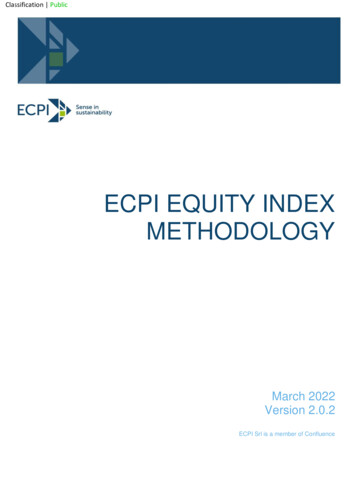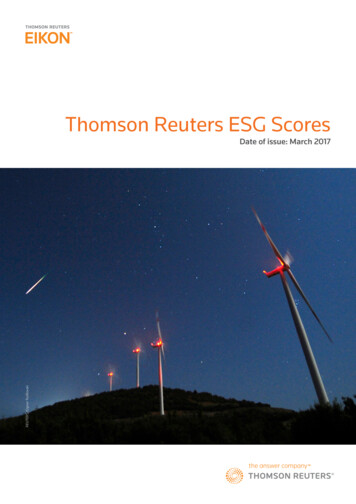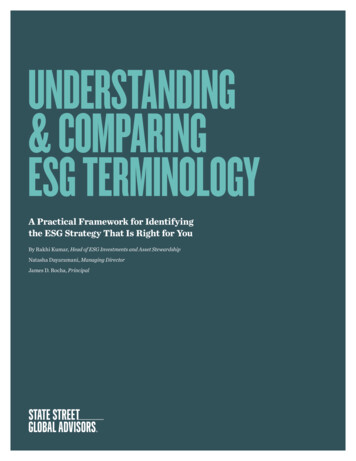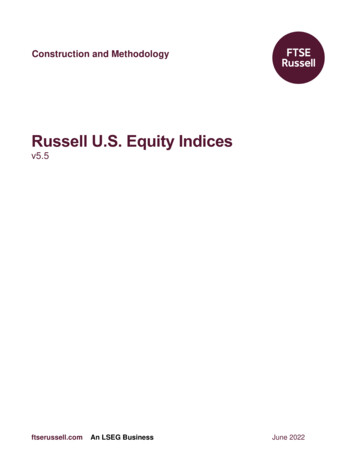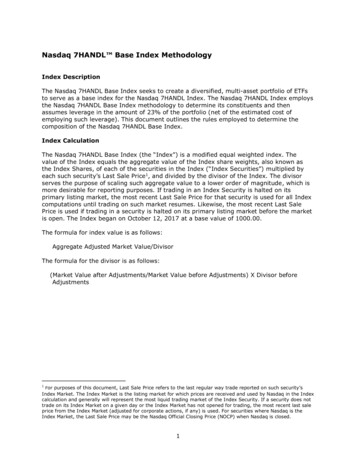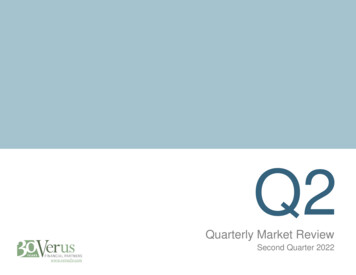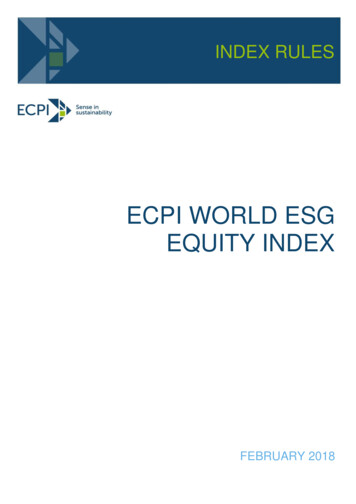
Transcription
INDEX RULESECPI WORLD ESGEQUITY INDEXFEBRUARY 2018
2TABLE OF CONTENTINTRODUCTION . 3GUIDING PRINCIPLES . 4INDEX CONSTRUCTION . 5CALCULATION METHOD . 7REVIEW . 9ADJUSTMENTS FOR CORPORATE ACTIONS . 10RETROSPECTIVE CHANGES TO PREVIOUSLY PUBLISHED INDEX VALUES . 11ECPI ESG SCREENING METHODOLOGY AND RATING . 11COMPLIANCE STATEMENT . 12APPENDIX A: DIVIDEND WITHHOLDING TAXES . 13APPENDIX B: DEFINITIONS . 14CONTACTS . 15Copyright 2018 by ECPI Group S.r.l. and ECP International S.A. All rights reserved.
3INTRODUCTIONThe present document defines the rules for the calculation and management of the ECPI World ESG Equity Index.The Index Rules and Index Constituents are available on ECPI’s website, www.ecpigroup.com, and/or can berequested at indices@ecpindices.com.The Index values are available on Bloomberg with the following identifiers:BLOOMBERG TICKERINDEX NAMEGALPHPWP IndexGALPHPWR IndexGALPHPWN IndexGALPHEWP IndexGALPHEWR IndexGALPHEWN IndexECPI World ESG Price IndexECPI World ESG Total Return IndexECPI World ESG Net Return IndexECPI World ESG Hedged Price IndexECPI World ESG Hedged Total Return IndexECPI World ESG Hedged Net Return IndexECPI SUSTAINABLE INDICESThe ECPI World ESG Index is designed to be a member of the broadest family of ECPI Sustainable Benchmarkand Tradable Indices.The objective of ECPI is that of providing the user with tradable indices that in their construction and managementtake into account, in addition to traditional financial criteria, also non-financial dimensions.All of ECPI Indices are characterized by (i) either a rigorous exclusion of companies that operate in certain sectorsin coherence with the ethical sensibility of the investor or by (ii) a positive selection of companies that demonstratea solid ESG profile.ECPI Indices may be used as the basis for various investment vehicles: they allow for an efficient implementationof socially responsible or sustainable mandates as well as index-tracking portfolios and exchange traded funds.Socially Responsible and Sustainability criteria used to select the indices’ constituents, offer a conduit for investorsto jointly express their interest in sustainability and, thus, to collectively move the relevant issues up the corporateagenda.ECPI Indices are managed by ECPI, which is responsible for: The index construction, management and distribution. The management of the indices selection criteria and of the review of all indices. The correct application of the Index Rules in maintaining the indices. The Socially Responsible selection criteria.ECPI may change existing socially responsible criteria, remove existing criteria or add new criteria.ECPI will endeavor to give notice before implementation of changes to selection criteria.Copyright 2018 by ECPI Group S.r.l. and ECP International S.A. All rights reserved.
4GUIDING PRINCIPLESThe ECPI Socially Responsible Equity Indices family is built and maintained according to the following principles: Market RepresentationThe indices represent the reference markets and reflect the opportunities available to the investors. Themain criteria used to ensure market representation are market capitalization and sector composition. Investible and ReplicableThe indices should be capable of being replicated by users, this objective is achieved by: free floatadjusting of constituent capitalization and selection of securities with reasonable size and liquidity. Disciplined ApproachECPI Indices are constructed and managed using a set of principles, rules and guidelines. This approachis followed to maintain the attributes of a benchmark, such as stability of the index, proper diversificationacross industries and securities and accurate respect of the socially responsible criteria. TransparencyThe indices are built and maintained using clear and transparent rules, available on public sources;moreover the indices are published daily on the most important financial info providers worldwide(Bloomberg, Thomson Reuters). Independence and ObjectivityThe indices are based on independent and objective content decisions. ECPI believes in an open dialoguewith its clients, considering with objectivity their suggestions to enhance the indices’ provision. Analyzing allthe feedback received by its clients, ECPI takes independently the final decision in order to preserve thequality of the indices. Continuity and Indices’ TurnoverECPI Indices are managed to ensuring the continuity of the indices. Continuity refers to the consistentapplication of the index methodology. The indices are also managed with the aim of keeping the level ofindex turnover relatively low, while at the same time reflecting the evolution of the reference market. SustainabilityEvery security which composes the indices has to satisfy defined socially responsible investment criteria.Copyright 2018 by ECPI Group S.r.l. and ECP International S.A. All rights reserved.
5INDEX CONSTRUCTIONEQUITY UNIVERSEThe index construction process starts with the identification of the Equity Universe. Equity securities with aminimum market capitalization of 400 million are eligible for inclusion in the Equity Universe.Investment trust, mutual funds, Exchange Traded Funds (ETFs) and equity derivatives are not included in theEquity Universe. Convertible and preference shares and loan stocks are excluded until converted.Where there are multiple lines of equity capital in a company, all are included and priced separately in the EquityUniverse.In general, companies and their respective securities are classified as belonging to the country in which they areincorporated.The country markets included in the Global Developed Equity Universe are:COUNTRY TABLE: ECPI WORLD ESG anceGermanyGreeceHong w ndUnited KingdomUnited StatesFinally, Companies which have an ESG rating less than E- (see pages 11-12) are not included in the EquityUniverse (minimum ESG Rating).INVESTABLE EQUITY UNIVERSEInvestable Equity Universe is derived by applying investability screens to securities in the Equity Universe.The investability screens used to determine the Investable Equity Universe are: Minimum Market CapitalizationMinimum Free Float Adjusted Market CapitalizationMinimum LiquidityMinimum Free FloatMinimum Market CapitalizationIn order to be included in the Investable Equity Universe must have a required minimum full market capitalization.The Minimum Market Capitalization is derived as follows: Companies in the Equity Universe are sorted in descending order of full market capitalization and and thecumulative coverage of the free float adjusted market capitalization of the Equity Universe is calculated ateach company.Copyright 2018 by ECPI Group S.r.l. and ECP International S.A. All rights reserved.
6 When the cumulative free float adjusted market capitalization coverage of 99% of the sorted EquityUniverse is achieved, the full market capitalization of the company at that point defines the EquityUniverse Minimum Market Capitalization Requirement. Companies with a full market capitalization lower than the Minimum Market Capitalization Requirementare excluded from the Investable Equity Universe.Minimum Free Float Adjusted Market CapitalizationThe adjusted market capitalization is defined as the total market capitalization multiplied by a free float factor.Companies with a free float adjusted market capitalization lower than the 150% of the Minimum MarketCapitalization Requirement are excluded from the Investable Equity Universe.Minimum LiquiditySecurities which do not turnover at least, on an annual basis, 20% of their current capitalization (after theapplication of any free float factor) prior to selection as an index constituent, are excluded from the InvestableEquity Universe.In exceptional market conditions, if trading volumes are very low ECPI may reduce the percentage figure statedabove in order to avoid a large amount of turnover in the Indices.Minimum Free FloatECPI estimate of free float is based on public available information obtained from multiple information sources.Estimated free float is rounded to the closest 5%.If the free float is less than 15%, the company is excluded from the Investable Equity Universe.SELECTION ALGORITHMOnce the Investable Equity Universe is defined, the selection process for the ECPI World ESG Index continuesaccording to the following steps: For each Country, companies are sorted in descending order of full market capitalization and thecumulative coverage of the free float-adjusted market capitalization of the Country Universe is calculatedat each company. European Countries are aggregated in just one region.EUROPEAN yPortugalSpainSwedenSwitzerlandUnited Kingdom Stocks - already included in the index current composition - comprised in the cumulative free floatadjusted market capitalization coverage of 95% of the sorted country universe are eligible for inclusion inthe index.New Stocks – not included in the index current composition - comprised in the cumulative free floatadjusted market capitalization coverage of 70% of the sorted country universe are eligible for inclusion inthe index. All eligible securities in each Country Universe are aggregated into the new index composition.Copyright 2018 by ECPI Group S.r.l. and ECP International S.A. All rights reserved.
7CALCULATION METHODCALCULATION FREQUENCYThe Index is calculated and published daily, on a next day basis.The only days the index is not calculated are on days when all exchanges where index’s constituents are listed areofficially closed.PRICESThe ECPI Equity Indices end-of-day calculations use closing trade prices.GMT WM Reuters Currency cross rates are used for the currency conversion.INDEX ALGORITHMThe actual trade price of securities is converted into Euro and the indices are then calculated using the algorithmdescribed below.The Price index is calculated as follows: PnI ( P) t I ( P) t 1 *i ,tff i N i 1n Pi ,t 1ff i N i1WhereI(P)t price index value on day tPt closing share price on day tNt number of shares in issue on day tffi free float factorn number of index constituentsThe gross (net) total return index is calculated as follows:n i Pi ,t ff i N i Di ,t ff i N i1I (TR) t I (TR) t 1 * 1n 1 Pi,t 1 ff i N i WhereI(TR)t total return index value on day tPi,t official closing price in Euro for stock i on day tDt gross (net) dividend in Euro on the ex-dividend date tNi number of shares for stock ii number of index constituentsffi free float factor Pi,tNi Index market capitalization on day tCopyright 2018 by ECPI Group S.r.l. and ECP International S.A. All rights reserved.
8 Di,tNi index dividend amount on day tThe net total return index uses net dividends instead of gross dividends (see tax rates in Appendix A).HEDGING ALGORITHMThe hedged index performance is calculated as the performance of the unhedged index in the base currency plusthe hedge impact in the base currency, as derived from the forward positions.The hedge impact (HI) is calculated according to the following formula:( ) {()}Wheret Index calculation dateNAF M First calendar day of the monthHI(t) Index Hedge Impact at time t Currency weight in the index 2 days before next month first day Spot rate of the currency i two business days before the start of the current calendar month. Thisterm determines the notional amount of the foreign currency to be sold corresponding to its weightin the index 1-month Forward for the currency i one business day before the start of the current calendarmonth (or last business day of the previous calendar month) Interpolated odd-days forward rate of the currency i on day t.The interpolated odd-days forward rate is calculated according to the following formula:{()}Where()The performance of the hedged index total return net is calculated as:(())( )Copyright 2018 by ECPI Group S.r.l. and ECP International S.A. All rights reserved.
9REVIEWEvery three months ECPI reviews the index constituents in order to ensure market representation.The rebalancing of the indices considers the financial and extra-financial evolution of the reference market. Theevolution may be due to economic and financial developments – such as a change in the composition or structureof an industry (e.g. changes in the market capitalization and representation of a company) - as well as to changesin the sustainability profile of the constituents.The environmental, social and governance performance of companies eligible for inclusion in the Indices ismonitored by ECPI; each constituent has to pass the ESG Screening.The rules for inserting and deleting securities at the periodic review are designed to provide stability in theselection of constituents of the indices, while ensuring the indices continue to be representative of the referencemarket.The Market Capitalization data used to update the investment universe and rebalance the indices are referred tothe day of selection’ previous business day closing (see timetable below).The timetable of the quarterly review is reported below.Below the reference calendar for the quarterly review.If the review day falls on a holiday, the subsequent working day will be considered.REVIEW TIMETABLETIME REFERENCEACTIONWHENt0Selectionof the new constituents1st Friday ofDec, Mar, Jun, Sept1Communicationof the new constituent1st Friday ofDec, Mar, Jun, Sept2Effective Date:the new index is effective3rd Friday (closing) ofDec, Mar, Jun, SepCopyright 2018 by ECPI Group S.r.l. and ECP International S.A. All rights reserved.
10ADJUSTMENTS FOR CORPORATE ACTIONSCorporate actions are treated by the index agent, S&P Dow Jones Indices, according to S&P Dow Jones Indices’Corporate Actions Policies & Practices Methodology.The following is an extract of S&P Dow Jones Indices Index Mathematics Methodology for Cap Weighted Indices:There are a large range of different corporate actions ranging from routine share issuances or buy backs tounusual events like spin-offs or mergers. These are listed on the table below with notes about the necessarychanges and whether the divisor is adjusted.DIVISORADJUSTMENTCORPORATE ACTIONINDEX ADJUSTMENTCompany added/deletedNet change in market value determines the divisor adjustment.YesChange in shares outstandingAny combination of secondary issuance, share repurchase or buy back –share counts revised to reflect change.YesStock splitShare count revised to reflect new count. Divisor adjustment is notrequired since the share count and price changes are offsetting.NoSpin-offIf the spun-off company is not being added to the index, the divisoradjustment reflects the decline in index market value (i.e., the value ofthe spun-off unit).YesSpin-offSpun-off company added to the index, no company removed from theindex.NoSpin-offSpun-off company added to the index, another company removed tokeep number of names fixed. Divisor adjustment reflects deletion.YesChange in IWFIncreasing (decreasing) the IWF increases (decreases) the total marketvalue of the index. The divisor change reflects the change in marketvalue caused by the change to an IWF.YesSpecial DividendWhen a company pays a special dividend the share price is assumed todrop by the amount of the dividend; the divisor adjustment reflects thisdrop in index market value.YesRights offeringEach shareholder receives the right to buy a proportional number ofadditional shares at a set (often discounted) price. The calculationassumes that the offering is fully subscribed. Divisor adjustment reflectsincrease in market cap measured as the shares issued multiplied by theprice paid.YesWith corporate actions where cash or other corporate assets are distributed to shareholders, the price of the stockwill gap down on the ex-dividend day (the first day when a new shareholder is not eligible to receive thedistribution.) The effect of the divisor adjustment is to prevent this price drop from causing a corresponding drop inthe index.For more information on the treatment of corporate actions, please refer to S&P Dow Jones Indices’ Equity IndicesPolicies & Practices document.Copyright 2018 by ECPI Group S.r.l. and ECP International S.A. All rights reserved.
11RETROSPECTIVE CHANGES TO PREVIOUSLY PUBLISHED INDEX VALUESThe ECPI Index Methodology does not allow retrospective changes to previously published index values(“Backfilling”). Divisor corrections, index input changes due to late dividend announcements and other similaradjustments are not considered “backfilling”.ECPI ESG SCREENING METHODOLOGY AND RATINGECPI research process follows an objective, rigorous and disciplined proprietary methodology that translatesqualitative data into quantitative indicators, assigning to each issuer an Environmental, Social and Governance(ESG) score and a rating.ECPI uses a rule-based non-discretionary approach considering approximately 100 key performance indicators toevaluate an issuer’s environmental, social and governance sustainability.PUBLIC INFORMATIONSOURCESECPI evaluates companies in the following areas7Environmental Strategy and Policy13Environmental Management3/4Products - sector specific6/11Production Process - sector specific9ENVIRONMENTALScore max 60Rating (9 notches)F EEEESG RATINGScore max 120Employees and Human CapitalRating (9 notches)12Community RelationsSOCIAL &GOVERNANCE11Markets19Corporate Governance &ShareholdersScore max 60Rating (9 notches)F EEEF EEEThe traditional pillars of ESG scrutiny are the following:“E”Environmental strategy, policy and management system. Industry-specific environmental impact ofproduction processes and products.“S”Social strategy and policy: assessing the quality of the company’s relationships with its stakeholders(customers, competitors, employees, management, public agencies and regulators, shareholders,creditors, local government and international institutions), market positioning and competitor analysis.“G”Governance structure: assessing both market and internal management issues, identifying the structure ofthe company’s governing bodies, its main operating characteristics, as well as the political andregulatory/legal specifics of the firm’s country of affiliation.The analysis produces a score and a rating. A company’s overall rating is the sum of the scores from eachindicator; the higher the final score, the higher the final rating.Copyright 2018 by ECPI Group S.r.l. and ECP International S.A. All rights reserved.
12ECPI’s proprietary rating scale ranges from “F” to “EEE”, along 9 notches.RATINGDEFINITIONVery goodThe company shows an innovative long-termstrategic attitude, strong operationalmanagement practices and proactive actionsto tackle social and environmental needs.GoodThe company shows a clear long-termstrategic attitude, sound operationalmanagement practices and positive actions totackle social and environmental needs.FairThe company shows a basic long-termstrategic attitude, standard operationalmanagement practices and/or average actionsto tackle social and environmental needs.PoorThe company shows a poor long-term strategicattitude, weak operational managementpractices and/or ineffective-negative actionsto tackle social and environmental needs.EEEEEEEE EEEEE EE-FNE*ECPI COMPANY RATINGLEVELControversialVERYGOODGOODFAIRPOOREEE EEE-EE EEEE-E E E-FThe company is involved in controversialsectors or activities.COMPLIANCE STATEMENTECPI Group keeps certain activities of its business units separate from each other in order to preserve theindependence and objectivity of their respective activities. As a result, certain business units ECPI group may haveinformation that is not available to other business units.ECPI Group has established policies and procedures that prohibit constituents to its indices to be included in anindex on the basis of payment volunteered from them.Copyright 2018 by ECPI Group S.r.l. and ECP International S.A. All rights reserved.
13APPENDIX A: DIVIDEND WITHHOLDING TAXESCOUNTRY iumBosniaBotswanaBrazilBrazil (Interest on Capital)BulgariaCambodiaCanadaChileChina (Mainland Incorporated)China (Offshore Incorporated)ColombiaCôte d’IvoireCroatiaCyprusCzech rgiaGermanyGhanaGreeceHong 2%0%15%10%0%0%10%15%15%COUNTRY NAMEMacedoniaMalaysiaMalaysia REITsMaltaMauritiusMexicoMexico REITs3MoroccoNamibiaNetherlandsNew nesPolandPortugalQatarRomaniaRussiaSaudi ArabiaSerbiaSingaporeSingapore REITsSlovakiaSloveniaSouth AfricaSouth KoreaSpainSri LankaSwedenSwitzerlandTaiwanThailandTrinidad & TobagoTunisiaTurkeyU.K. CorporationsU.K. REITSU.S.UkraineUnited Arab 20%30%15%0%34%0%15%Data as of September 1, 2017Copyright 2018 by ECPI Group S.r.l. and ECP International S.A. All rights reserved.
14APPENDIX B: DEFINITIONSIndex Constituent or ConstituentAny security comprised in the index, provided that on any Reference Date and in the relevant Rebalance Period,Constituent shall include any stock which will be included in the index as of the next Rebalance Date at the end ofsuch Rebalance Period.Rebalance PeriodIt is the timeframe between Reference Date and Rebalance Date.Exchange and Related ExchangeEach exchange on which any Index Constituent is, in the determination of ECPI, principally traded.Scheduled Trading DayAny day on which each Exchange and each Related Exchange are scheduled to be open for trading for theirrespective regular trading session.Disrupted DayAny Scheduled Trading Day on which: (i) a relevant Exchange or any Related Exchange fails to open for tradingduring its regular trading session; or (ii) a Market Disruption Event has occurred.Market Disruption EventThe occurrence, in respect of the Index Constituent of: a Trading Disruption an Exchange Disruption an Early Closurewhere the aggregate of all Index Constituents in respect of which a Trading Disruption, an Exchange Disruption oran Early Closure occurs, comprises 20 per cent or more of the aggregate number of all Index Constituents forwhich the Exchange and Related Exchange were scheduled to be open for trading for its regular trading sessionon such day.Trading DisruptionAny suspension of or limitation imposed on trading by the Relevant Exchange or Related Exchange or otherwiseand whether by reason of movements in price exceeding limits permitted by the Relevant Exchange and RelatedExchange or otherwise.Exchange DisruptionAny event that disrupts or impairs the ability of market participants in general to effect transaction in, or obtainmarket values for the Index Constituents.Early ClosureThe closure on any Exchange Business Day of the Relevant Exchange or any Related Exchange prior to itsScheduled Closing Time.Copyright 2018 by ECPI Group S.r.l. and ECP International S.A. All rights reserved.
15CONTACTSIndex Dept.T 39 02 97 16 57 17indices@ecpindices.comFilippo BucciT 39 02 97 16 57 : ECPSReuters: ECAPITALDisclaimerThis document has been prepared by ECPI Group S.r.l., a company organized and existing under the laws of Italy, with registered office at ViaCaradosso, 7 - 20123 Milan, Italy (the “ECPI Group Companies”) as part of their internal research activity. The information provided herein and,in particular, the data contained in this document are taken from information available to the public. All information contained herein is obtainedfrom sources believed by it to be accurate and reliable. While the opinions and information contained in this document are based on publicsources believed to be reliable and in good faith, ECPI Group Companies have not independently verified the accuracy of such public sources.Because of the possibility of human, technical or whatsoever kind of similar error, however, such information is provided “as is” without warrantyof any kind and ECPI Group Companies, in particular, make no representation or warranty, whether express or implicit, as to the fairness,accuracy, timeliness, completeness, merchantability and/or fitness of any such information and opinions contained in this document.Accordingly, neither ECPI Group Companies nor any of their respective directors, managers, officers or employees shall be held liable forwhatever reason (including, without limitation, liability in negligence) for any loss (including consequential loss), expense, consequential,special, incidental, direct or indirect or similar damage, whether or not advised of the possibility of such damage, in connection with the fairness,accuracy, timeliness, completeness, merchantability and/or fitness of the information and opinions contained in this document and/or arisingfrom any use or performance of this document or its contents or otherwise arising in connection with this document.Any opinions, forecasts or estimates contained herein constitute a high-level information statement only valid as at the date of its release. Therecan be no assurance that the evolution of the information contained herein and/or any future events will be consistent with such opinions,forecasts or estimates. Any information herein is at any time subject to change, update or amendment subsequently to the date of thisdocument, with no undertaking by ECPI Group Companies to notify such change, update or amendment.This document is not, nor may it be construed as to constitute a recommendation to make any kind of investment decision or an offer for sale orsubscription of or a solicitation of any offer to buy or subscribe for any financial instrument. Accordingly, this document may not be used as asolicitation or an offer for sale or subscription, and any solicitation or offer shall be made only in accordance with all applicable laws andregulation, including, whenever applicable, the filing of a prospectus with the relevant authorities. ECPI Group Companies are not financialadvisors subject to special authorization and thus do not provide formal financial advice in the area of investment nor perform any assetmanagement activity. ECPI Group Companies recommend to potential investors wishing to be provided with formal financial advice in the areaof investment to contact a financial advisor duly authorized by the competent regulatory authority of its country.ECPI Group Companies publish researches on a regular basis. This publication has been prepared on behalf of ECPI Group Companies solelyfor information purposes. All the information contained herein is copyrighted in the name of ECPI Group Companies, and none of suchinformation may be copied or otherwise reproduced, except for personal use only, further transmitted, transferred, published, disseminated,redistributed or resold, in whole or in part, in any form or manner or by any means whatsoever, by any person without ECPI Group Companies’prior written consent.Copyright 2018 by ECPI Group S.r.l. and ECP International S.A. All rights reserved.
ECPI estimate of free float is based on public available information obtained from multiple information sources. Estimated free float is rounded to the closest 5%. If the free float is less than 15%, the company is excluded from the Investable Equity Universe.


